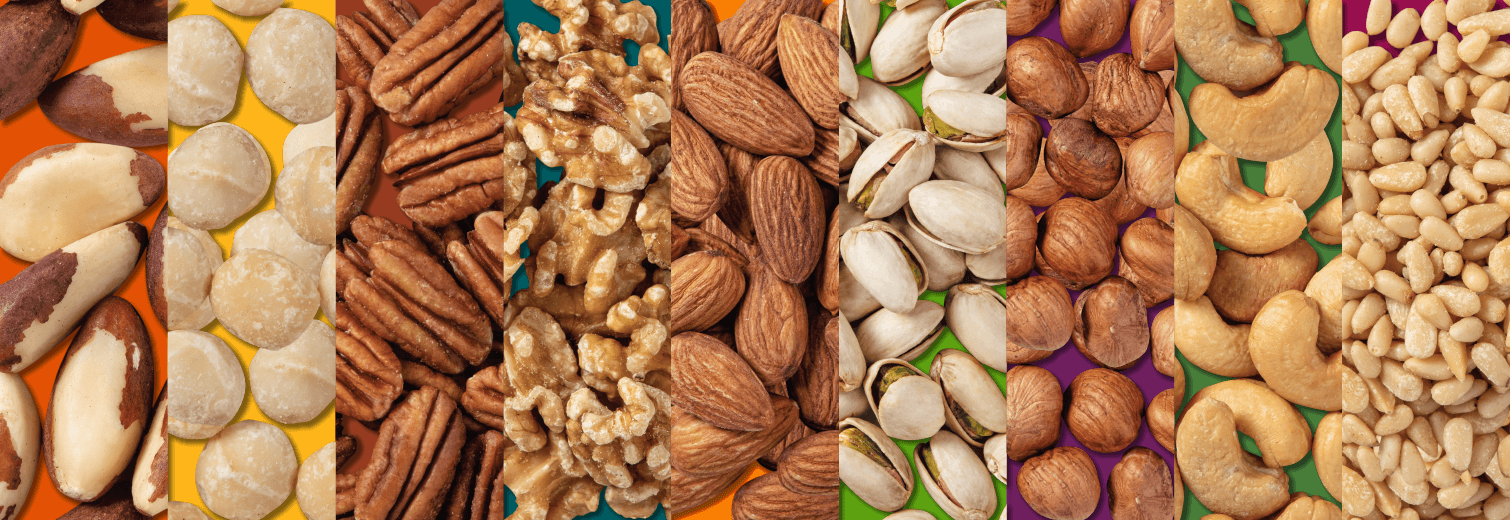Blog

The Global Nutrition Powerhouse – Nuts!
Throughout history nuts have played a significant role in the diets and health of cultures around the world and have formed the staples of many dishes intrinsic to their cuisines. From sustaining explorers to being featured in celebrations, nuts have enjoyed a universal appeal. Let’s have a look at the origins of some tree nuts and classic ways they can inspire us in our daily nut creations:
Almonds – Mentioned in the bible and Greek Mythology, almond history mainly revolves around the Mediterranean and particularly Spain. From soups like Ajo Blanco, where almonds give a silky creaminess, to a rich Romesco Sauce from the Catalan region, where almonds combine with roasted peppers and spices to make a delicious addition to fish and other dishes. And a tapas platter would be incomplete without some paprika spiced Marcona almonds.
Brazil Nuts – Grown mainly in the lowland Amazon rainforests, Brazil nuts are native to Southern American cuisine. Brazil nut trees sometimes live 500 years or more and grow up to 165 feet. Many organizations work tirelessly to preserve the forests where these valuable selenium-rich nuts grow, supporting the livelihoods of families reliant on their harvest. Many from the region simply slice the nut to toast and toss with herbs as a healthy protein rich snack, but in Peru, their Brazil Nut turrón will rival any Spanish or Italian equivalent.
Cashew Nuts – Though most associate cashew nuts with India, the nut actually hails from South America. Portuguese colonists were responsible for introducing the nut to West Africa and India in the 16th Century, and now the nut is commonly used in South Asian cuisine. Cashews are used whole for garnishing sweets, curries, stir fries, or Sang Choy Bow, or ground into a paste that forms a base of sauces for curries (e.g., korma).
Hazelnuts – A symbol of wisdom, fertility and knowledge, the hazelnut has been found in writings dating back centuries from China to Greece. Originally believed to have been from Asia minor, the nut spread all over Europe, particularly embraced by countries such as Turkey and Italy. One traditional Turkish dish featuring hazelnuts is Bafra, which every home makes at celebrations. It’s simply a thin yeast dough sprinkled with sugar, hazelnuts and raisins, rolled up into a cylinder and baked. You could just use filo pastry to make your own simpler version. In Italy, Torta Nocciola can be found in bakeries everywhere, and farmers take their abundance of hazelnuts to local oil producers to make hazelnut oil, which is wonderfully aromatic on salads.
Macadamias – Contrary to popular belief, macadamias are actually native to Australia, being one of the main forms of sustenance for indigenous Australians on walkabouts. The tree was, however, first commercially harvested in Hawaii. Being a relatively “new” discovery, most recipes featuring macadamias are modern and creative, making use of the creamy, crisp texture and buttery flavor. They make a wonderful butter replacement in shortbread, and macadamia crusted fish appears on menus around the world.
Pecans – The only tree nut actually native to America is the pecan, and it is a species of the hickory tree. Pecan use dates back to the 1500’s where it was found along riverbeds in the south east US and northern Mexico, particularly around the Mississippi region. It was a staple of the pre-colonial American diet, being used in Fall and Winter and often used to make a nut milk, or soups and breads. Kanuchi is a Cherokee soup in which pecans are pureed with salt and water and usually topped with roasted squash. Pecan pie is one of the most famous American desserts, but pecans are now widely used in salads, cheese boards, muffins and just as a delicious snack.
Pistachios – A relative of the cashew, the pistachio originated in the Middle East, and is mentioned in the book of Genesis. Historically the nut was savored by the wealthy and royalty, and it wasn’t until after WWII that the pistachio became more mainstream. While it was still considered a delicacy in France and countries north of the alps, Italy found a way to incorporate the nut in their cuisine, from delicate cookies, gelato and even as a pizza topping.
Walnuts – Walnuts are one of the oldest food trees known to man, dating back to 7,000 BC. Once named Juglans regia, “Jupiter’s royal acorn,” historical records suggest the nut came from Persia where it was saved for royalty. A classic Persian dish is Fesenjan, featuring a walnut and pomegranate stew with chicken. In the Mediterranean they are intrinsic to many dishes, from an Italian walnut sauce for pasta, to Greek Walnut bread.
So, globalize your kitchen, expand your culinary repertoire and Go Nuts!
previous post
Go Nuts for Heart Month